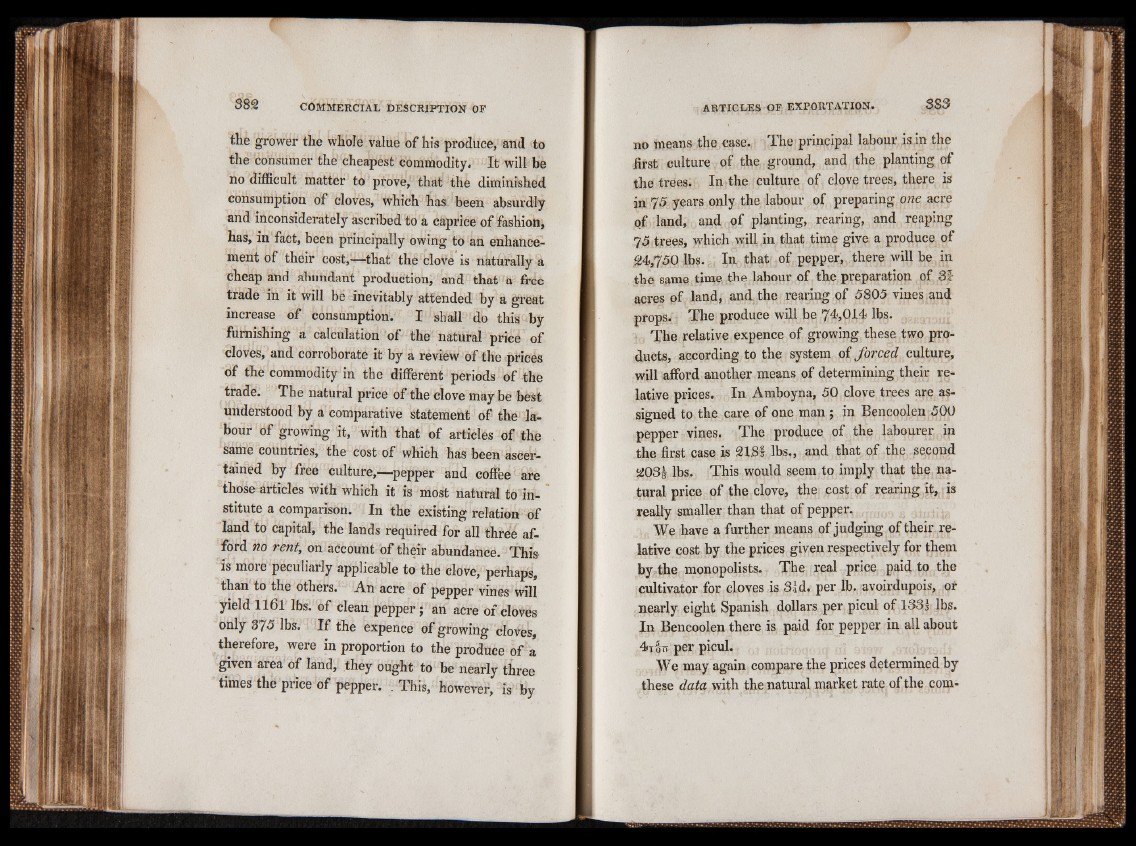
the grower the whole value of his produce, and to
the consumer the cheapest commodity. It will be
no difficult matter to prove, that the diminished
consumption of cloves, which has been absurdly
and inconsiderately ascribed to a caprice of fashion,
has, in fact, been principally owing to an enhancement
of their cost,—that the clove is naturally a
cheap and abundant production* and that a free
trade in it will be inevitably attended by a great
increase of consumption. I shall do this by
furnishing a calculation of the natural price of
cloves, and corroborate it by a review of the prices
of the commodity in the different periods of the
trade. The natural price of the clove may be best
understood by a comparative statement of the labour
of growing it, with that of articles of the
same countries, the cost of which has been ascertained
by free culture,—pepper and coffee are
those articles with which it is most natural to institute
a comparison. In the existing relation of
land to capital, the lands required for all three afford
no rent, on account of their abundance. This
is moie peculiarly applicable to the clove, perhaps,
than to the others. An acre of pepper vines will
yield 1161 lbs. of clean pepperj an acre of cloves
only 375 lbs. If the expence of growing cloves,
therefore, were in proportion to the produce of a
given area of land, they ought to be nearly three
times the price of pepper. This, however, is by
no means the case.. The principal labour is.in the
first culture of the ground, and the planting of
the trees. In the ¡Culture of clove trees, there is
in 75 years only the labour of preparing one acre
of land,; ( and of planting, rearing, and reaping
75 trees, which will in that time give a produce of
24,750 lbs., In that of pepper, there will be in
t h e s a m e time the labour of the preparation of 3f
acres of land, and, the rearing of 5805 vines and
props. The produce will be 74,014 lbs.
The relative expence of growing these two products,
according to the system of forced culture,
will afford another means of determining their relative
prices. In Amboyna, 50 clove trees are assigned
to the care of one man ; in Bencoolen 500
pepper vines. The produce of the labourer in
the first case is 21.81 lbs,, and that of the second
203| lbs. This would seem to imply that the natural
price of the clove, the cost of rearing it, is
really smaller than that of pepper.
We have a further means of judging of their relative
cost by the prices given respectively for them
by the monopolists. The real price paid to the
cultivator for cloves is .Sid. per lb. avoirdupois, or
nearly eight Spanish dollars per picul of 1331 lbs.
Jn Bencoolen there is paid for pepper in all about
4i q-tt per picul.
We may again compare the prices determined by
these data with the natural market rate of the com*